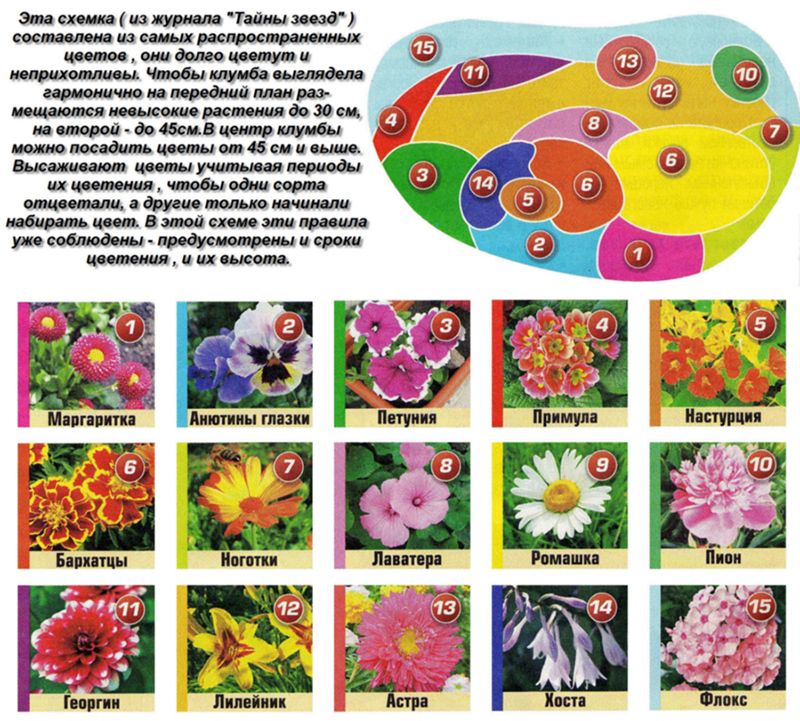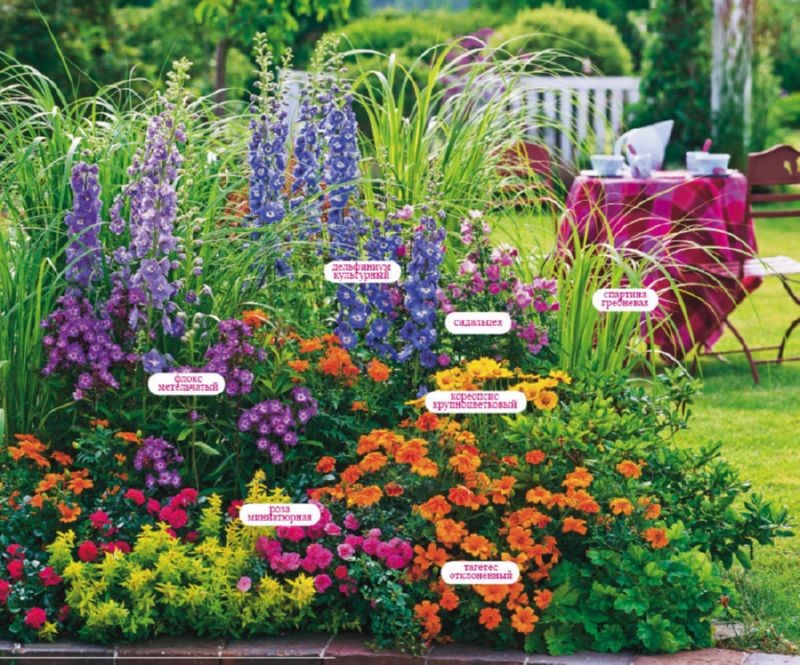How to make a flower garden of continuous flowering from perennials. A flower bed of continuous flowering or how to make your garden bloom all season
A flower bed of continuous flowering is a flower bed, decorative and giving joy and good mood throughout the season. Choosing the right plants, you will get a flower bed of continuous flowering.
Flowerbed of continuous flowering
Creating a flower garden or flower bed is a creative process and every grower is akin to an artist painting a picture. However, in addition to color combinations and the shape of flowers, many factors must be taken into account, such as the time and period of flowering of each individual plant and its growing conditions. How to plant flowers so that the flower bed is blooming and beautiful, pleasing to the eye and uplifting throughout the season, and maybe even more - all year round?
It is about the creation of such a flower bed of continuous flowering that we will talk today.
I want to say right away that a flower bed of continuous flowering from perennials should be created if you have a fairly large area of \u200b\u200bland allocated for it, otherwise it will be difficult to get the desired effect, it will turn out small fragments of flowering plants in each time period. In a small area, it is better to place a seasonal flower garden, or choose annual flowers for its decoration, or pick up decorative foliage plants plus long-flowering perennials.
In order for the flower bed to please with flowering from early spring to late autumn, you need to pick up a perennial plant with different periods flowering, add profusely and long-blooming annuals to them, and do not forget to include ornamental plants in the composition, and, for example, and.
Take paper, colored pencils and try to draw a diagram of a flower garden. So it will be easier for you to decide on the choice of plants and their number. First, draw an outline, your flower garden can be round, rectangular, triangular, or have some curly shape. Then place taller plants in the center, mark them with circles of the color of the flowers of future plants, and lower ones closer to the edge. If the flower garden is located near a wall or fence, then tall plants will, respectively, also be located from this edge. You can draw three or even four such diagrams to imagine what the flower garden will look like, what colors will be present in it at different times of the year.
To make it easier for you, let's take a closer look at the main plants most often included in such compositions:
The basis of any flower arrangement is usually perennials or ornamental shrubs. Their choice will depend on the area that you are willing to give under the flower garden and the location of the place relative to the light, that is, whether the flower bed will be located in the sun or in the shade.
Shrubs for flower beds of continuous flowering
As for high , then it is worth including them in the composition if the flower bed is large enough and if it is not too close to the viewpoint. That is, if your flower garden is located right next to the path, then tall shrubs or any other tall plants should not be planted there, otherwise the composition will lose its integrity, since the human eye is not able to catch too large gaps in height at close range. There is such a rule that the plants in the flower garden should be as high as half the distance between the flower garden and the main viewpoint. That is, if the flower bed is viewed from a distance of at least three meters, then it would be quite appropriate to plant tall 1.5-meter plants on it. For a medium-sized flower garden, you can pick up one or two, maximum three beautiful bush, preferably of the same kind. These can be, for example, tunberga, varied in leaf color and decorative throughout the season, mock orange, blooming in June with white fragrant flowers reminiscent of jasmine in aroma, coniferous juniper that will decorate your garden in winter, tree-like or paniculate, flowering , Kuril tea, various spireas, etc.
Perennials for flower beds of continuous flowering
It is perennials that form the basis of most flower arrangements. They are loved both for their beauty and unpretentiousness, but in general, having planted and grown them once, every year they will delight you and become more beautiful. However, it is impossible to find perennials with a very long flowering period that would bloom from early spring to late autumn. Therefore, it is important to choose perennial plants so that the flowering of one succeeds the flowering of the next, and those, in turn, fading, also pass on their baton.
- perennials for spring - these are, of course, bulbous and. Be sure to plant in a flower garden of various colors and, as well as various small-bulbous:, etc., bloom from rhizomes in spring,. At the end of May - June bloom, ground cover, etc.
- perennials for summer.
Their selection is simply huge. When creating beds of continuous flowering, preference should be given to the most long-flowering ones, as well as those that can bloom twice a season. Long-flowering plants, for example, include, or navel. In early summer, in June-July, the garden will be decorated, and, and in July-August, lilies and panicled phloxes will delight you.
- perennials for autumn - this is definitely
A flowerbed of continuous flowering is a great opportunity to make your garden even richer and more noticeable. Imagine - the flower garden will delight you absolutely the whole season. To do this, you need to choose varieties of flowers, draw up a plan for a flower bed of continuous flowering and properly care for it.
1 Plants for a flower bed of continuous flowering
The appearance of the flower garden largely depends on the selected plants. As a rule, the basis of the entire composition consists of various shrubs and perennials. They should be chosen, paying attention to the size of the flower bed, location on the territory, type of soil. If you are going to decorate a large flower garden, be sure to opt for shrubs.
- In the spring, they begin to wake up, planted before the winter season. Among them, the most famous are daffodils. You can also combine corylopsis, crocus and forsythia bushes with each other.
- Closer to summer, perennials bloom. If you want to make your flower garden brighter, choose forget-me-nots and pansies. The main role is best assigned to long-flowering varieties or plant species that re-bloom in autumn: navel, catnip, yarrow, fragrant geranium, soul mate.
- In autumn, we will be pleased with coreopsis, warm asters, rudbeckia, geleniums, which are distinguished by incredibly rich colors. You can also frame the composition with ornamental grasses, including miscanthus and switchgrass.
A competent combination of these plants will allow you to enjoy a flowering and lush flower bed all season long.
2 Flower bed of continuous flowering - planting scheme
Before you start creating a flower garden, draw a future sketch on paper with notes on the location of the plants and an indication of their flowering period. At the same time, the patterns of continuous flowering flower beds can be different, the most important thing is to plant flowers and plants evenly. For example, if you want to get a flower garden in white and yellow colors, you need to use varieties such as chamomile, coreopsis, chrysanthemums, lilies. It is important to choose plants of only the appropriate color.
For the foreground of the flower garden, you can choose coreopsis or lily of the valley. Plants of this species either alternate or are planted in small groups. After that, chrysanthemums are lower in height, then daisies with an average "growth" need to be planted. The highest flowers of our composition - lilies, must be placed in the very last row. Thus, lilies of the valley will bloom the very first, daisies will delight from May to June, coreopsis blooms until August, lilies bloom from mid-summer to October, and the chrysanthemum season ends.
Examples of continuous flowering flower beds can be different, even a novice gardener can handle their creation. The most important thing is to choose the right plants according to the time of their development and shade, so that the principle of harmony is observed.
3 How to create a flower bed of continuous flowering - tips for beginners
It is also important to consider the location of the flower bed. Any gardener knows that plants "follow" the sun's rays. If the flower garden opens to us from the dark side, then part of the day the plants will be turned away from us. It is best to plant more on such a flower garden: marigolds, liatris, lupins, zinnias, delphiniums. When planting seedlings and bulbs, leave enough space between them. And do not worry that the flower bed will be somewhat empty until the summer, but in the future you will not have to constantly weed it, making room for a normal neighborhood between flowers.
When planning a structure, familiarize yourself with the height of the plants and observe the distance between flowers of the same variety. If the sown seeds have sprouted often enough, carefully dig them out and transfer them to another bed. True, here you need to monitor how some varieties tolerate planting, so as not to harm them. Already in the summer or early autumn, start thinking about how your flower garden will look next year: pick up plants, find a place on the site. This will allow you to get a bright flower bed at the beginning of spring.
4 Faithful care or how to extend the life of a flower bed?
Picking flowers and planting them is part of the job. You can not do without competent care, which consists in constant watering, proper feeding with fertilizers, loosening. It is important to remove fallen inflorescences on time. If empty spaces appear between the plants, you can easily fill them with small pebbles, decorative filling, small sculptures.
Heat-loving perennials for the winter should be covered with a film so that the root system does not freeze. Do not forget to also update the plants: remove the old ones, and plant new ones over time. And if first you create simple flower beds continuous flowering, then in the future, having learned to combine different varieties of plants, you will be able to arrange incredible appearance flower beds.
Many summer residents, creating flower beds on their site, are faced with the problem of inconsistent flowering of some plants. When half of the plants in one part of the flower garden are raging with colors, others are already going through the drying stage, and still others are not going to bloom at all.
The problem can be solved by choosing plants that bloom at about the same time. Then the flower bed will look harmonious and complete. But keep in mind that it will bloom only a few months of the year. The rest of the time, the flower bed will be in a dormant period or completely dry out.
Then gardeners developed a new type of flower bed, which became an alternative to all other types of flower beds. Its main aspect is the presence in the soil at least three layers of seeds, usually four, five or more. Each layer has its own ripening period, and most importantly - flowering. Properly selected layers will allow the flower bed to continuously reproduce a new generation of flowers throughout the warm season.
The greater the variety of colors will be in the composition of the flower bed, the more difficult it is to pick up a truly harmonious complex in advance, which will not look like an unbridled heap of colors and shapes from the outside.
How to create such a flower bed?
In order to successfully design a flower bed, several main rules.
- Start creating a flower bed on paper. It is better to work out the design of the flower garden with high quality than to observe flowers all season later that will not please the eye and violate the aesthetic appearance of the entire garden. Usually do scale plan the area that they want to allocate for a flower bed. If its area is large enough, then the flower bed should include approaches(paths, bridges, paths) to all colors.
- One of the main points in creating a flower bed is the right choice color range of plants, as well as their size and height. You need to know what this or that flower looks like, its ability to develop on the ground and the most accurate dates for the beginning and end of flowering.
- Do not forget that some plants need special fertilizers which other flowers may not tolerate.
- If the flower bed will be viewed only from one side, then it is necessary to place the plants longline, according to the degree of growth of each, starting from the lowest, ending with the highest.
- The area where it is planned to plant flowers should be partially shaded. Most plants do not tolerate direct sunlight. And you run the risk of getting not fresh bright flowers, but dried, wilted and faded.
- A completely unexpected nuance is which side to look at the flower bed. Remember that the inflorescences themselves always look towards the sun and can literally “turn away” from you.
Properly selected plants are the key to success
Flower ripening time is divided into three seasons: spring, summer and autumn. However, do not forget that this is a very conditional designation.
For accurate selection of plants, each of these seasons should be divided by months.
spring beauty
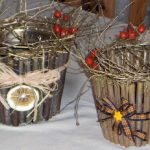
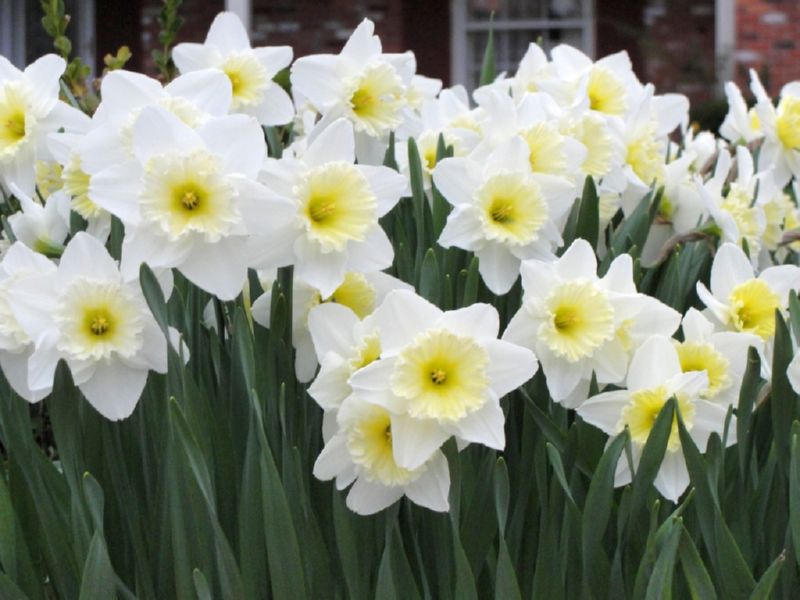

What to plant in March
The earliest birds in March are many bulbous and tuberous flowers. They need to be planted in the fall and carry out additional care measures: create a drainage system, monitor humidity, prevent drafts, and cover in severe frosts.
Principal Representatives March flowers are:
- snowdrop,
- crocus,
- hellebore,
- Tulip is excellent.
What to plant in April
April flowers are already more diverse, they have a wide range of colors and shapes. At the gardener more choice than in March.
Do not forget that due to late spring, some March flowers may bloom at the same time as April ones.
In April flowering plants such as:
- narcissus,
- muscari,
- chionodox,
- erythronium european,
- white flower,
- blueberry.
What to plant in May
In May a huge number of plants bloom. One of them:
- hyacinths,
- bathing suits,
- grouse,
- primrose,
- lily of the valley,
- dicentra,
- pansies.
And if you plan to create a perennial flower bed, then do not forget about lilac and jasmine.
This is a very interesting and, most importantly, useful activity. Try!
To make your garden plot beautiful and cozy, it is not necessary to contact professional designers. You can do everything yourself. Useful information on this subject you will find .
Summer riot of colors
With the beginning of summer, there are usually no problems with the choice of plants. Gardeners have the opportunity to work with quite a wide variety of plants: vary their sizes, play with the color palette and choose what they like.
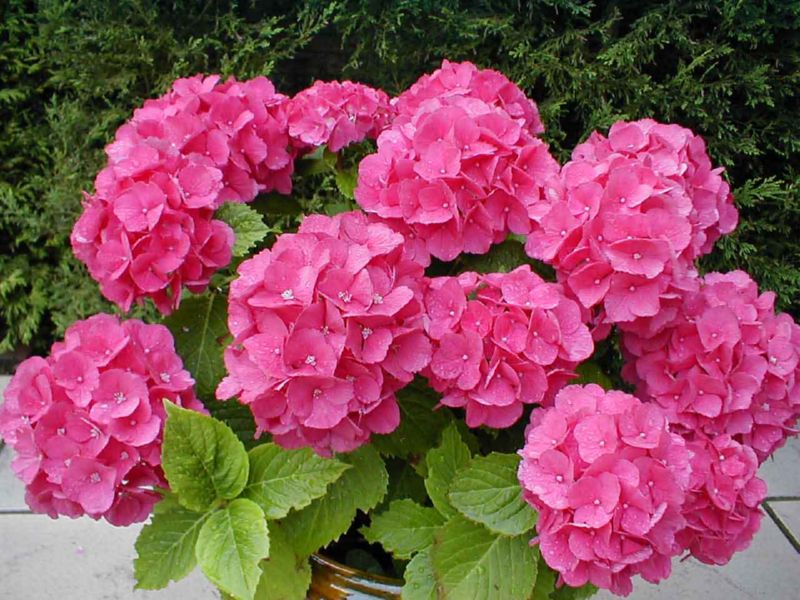
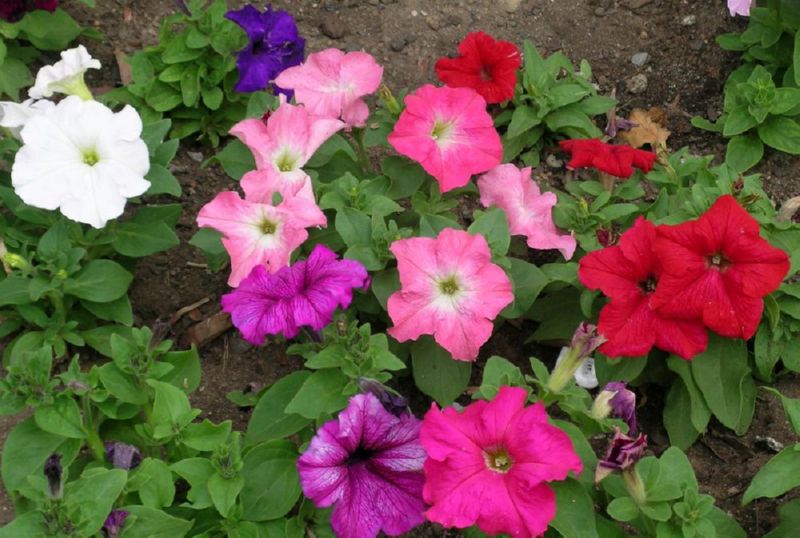
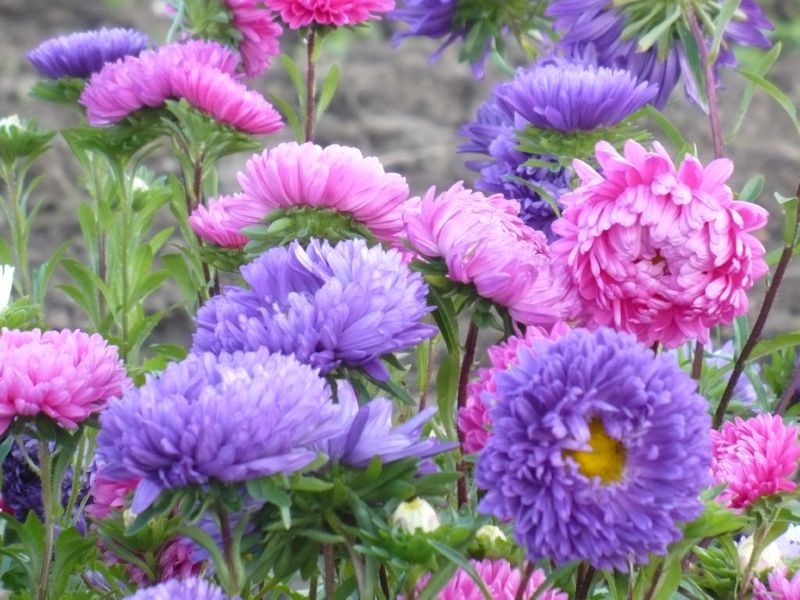
What to plant in June
- petunia,
- carnation Shabo,
- lobelia,
- begonia,
- delphinium,
- day-lily,
- lilies,
- lupine,
- peony.
What to plant in July
- marigold,
- hydrangea,
- verbena,
- tekoma,
- echinacea,
- carnation,
- lavender,
- roses,
- morning glory.
What to plant in August
- asters,
- gladioli,
- lilies,
- phlox,
- dahlias,
- goldenrod,
- montbrecia.
autumn tenderness
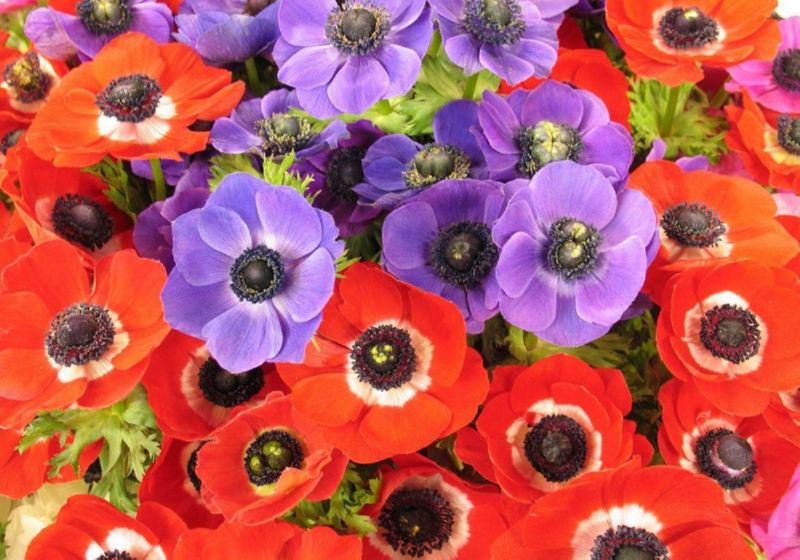
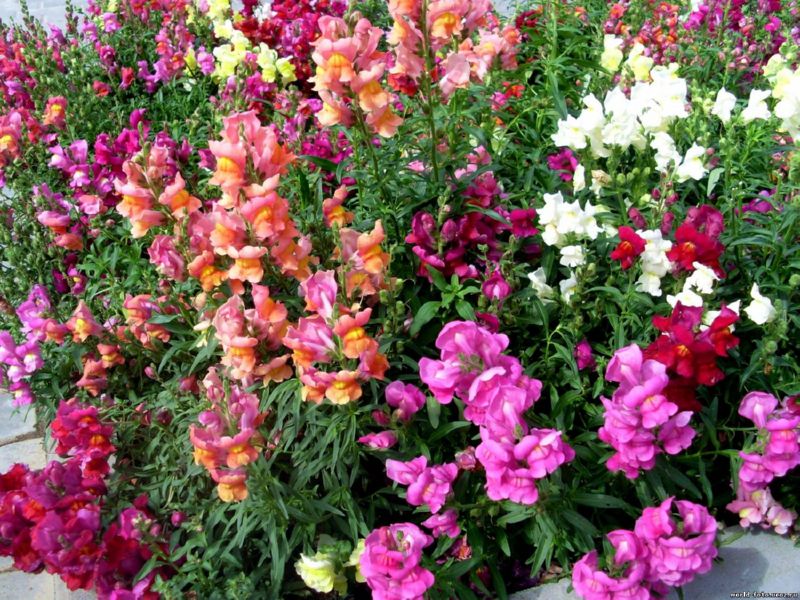
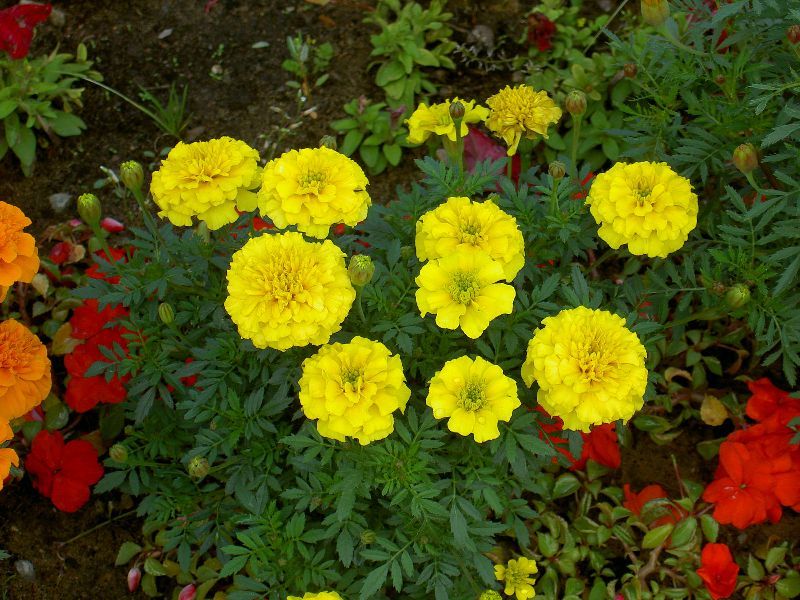
What to plant in September
In September it is still quite warm and the presence of flowers in the yards is a very common phenomenon. The leaves on the trees are still green, the weather is warm, and the wide range of September flowers helps prolong the summer mood a little more. This gardeners help:
- anemones,
- stonecrop prominent,
- violets,
- chinese gentian,
- foxtail pennisetum,
- saxifrage cortuzolifolia,
- purple vine.
What to plant in October
This month, you can support the autumn golden-red mood by picking up yellow, orange and red flowers, namely:
- Snapdragon,
- salvia,
- glazing,
- lantana,
- kobeya,
- floribunda.
What to plant in November
Since November is unpredictable with its weather, in order for your flower bed to be more likely to bloom, you should choose the maximum cold hardy flowers. This is not easy to do, but it is possible. There are a number of plants that can bloom in November, even at relatively low temperatures.
- marigolds rejected,
- abelia grandiflora,
- hubei anemone,
- yucca aloe.
Some summer residents in creating a perennial flower bed take into account and winter. To maintain brightness, juniper, cypress can be placed in the center. Can be sown in places lawn grass which retains its color even under the snow.
And this evergreen, like rhododendron, can re-bloom in the fall and, under favorable conditions, retain its color until winter.
The role of perennials in composition planning
In order not to design a flower bed every year, and not to sow it every time with new seeds, gardeners successfully apply the practice of creating a perennial flower bed. The composition of perennials is based on plants that live for several years.
When developing a flower bed plan, take into account the impossibility of autumn planting bulbous plants during the ongoing flowering of late species. To avoid such misunderstandings when creating a perennial flower bed, gardeners have to either develop a more thorough flower bed plan, or use only perennials.
Naturally, the spectrum perennials much narrower, and it is more difficult to design a scheme using only such colors. However, in the future, such a flower bed will justify itself.
Landing patterns
